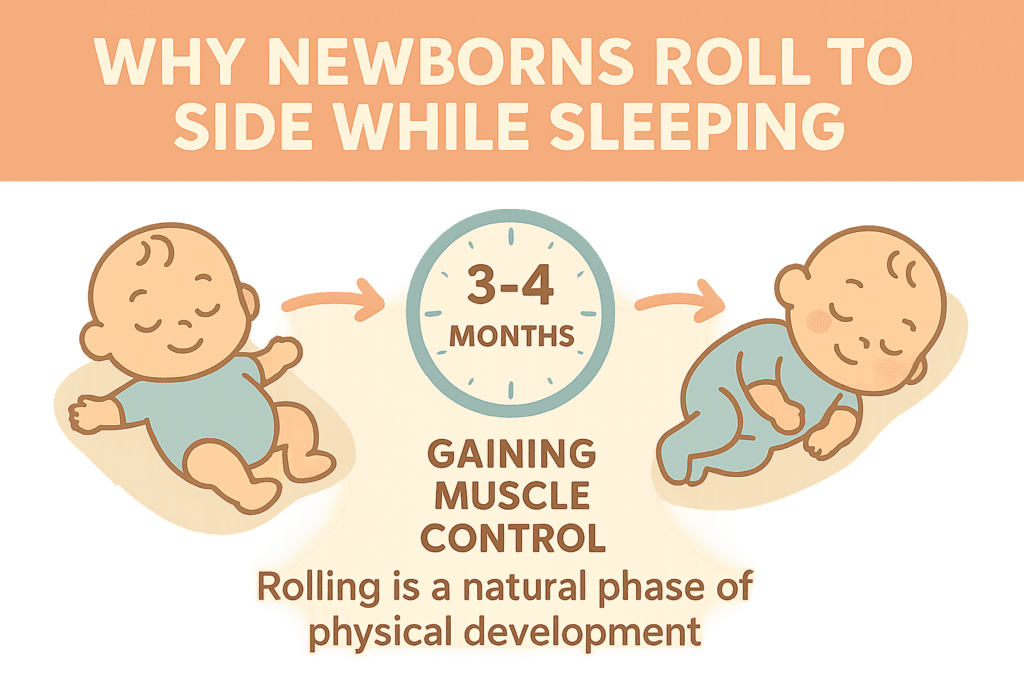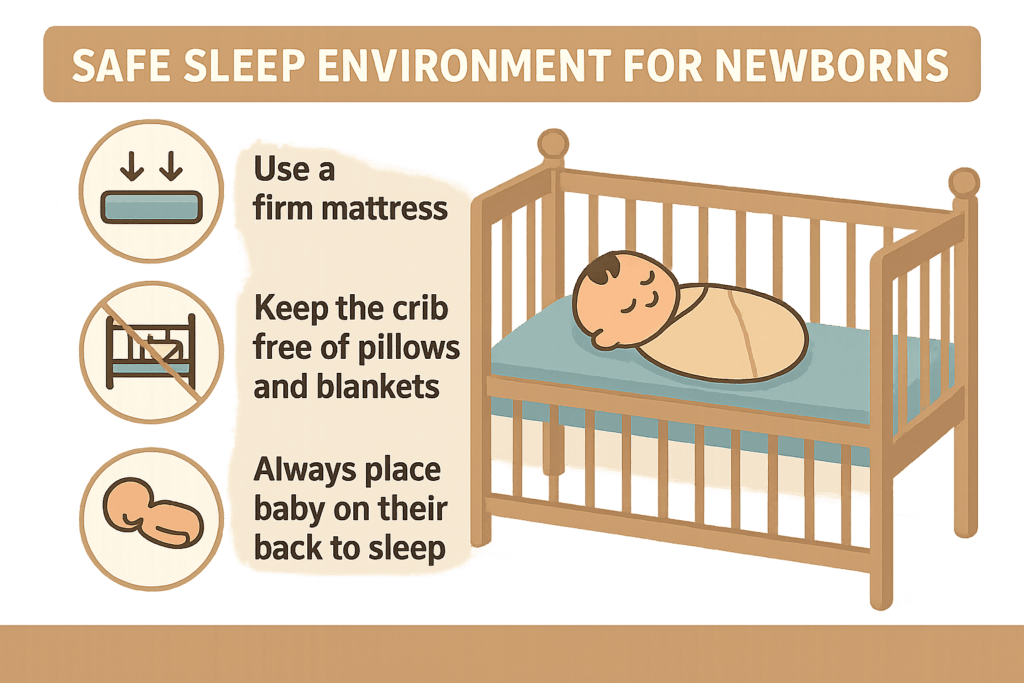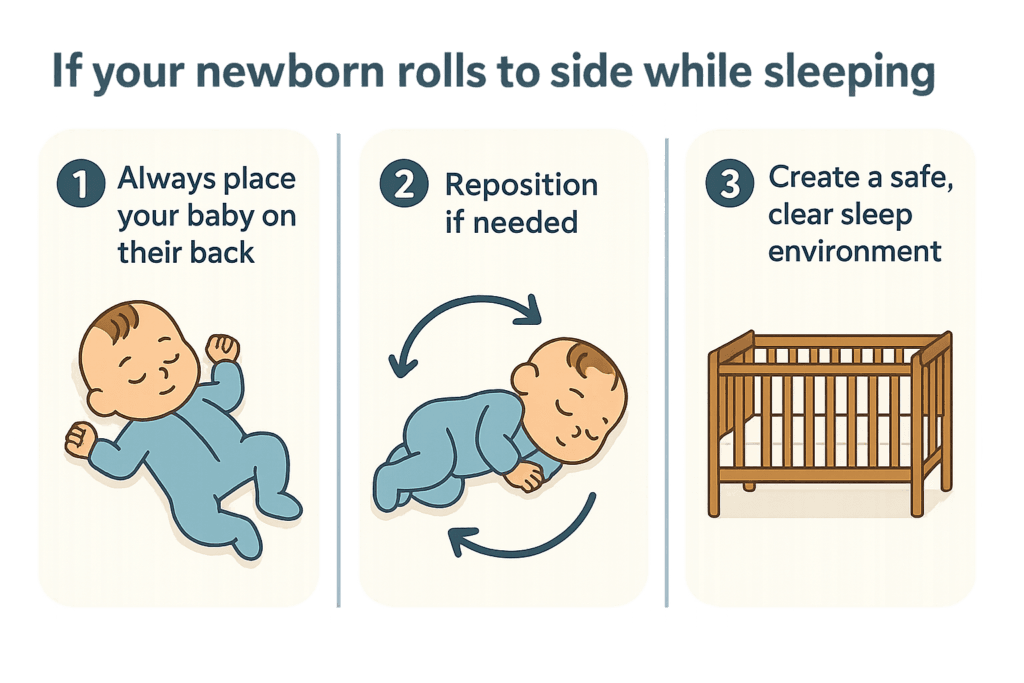As parents, it’s completely normal to be concerned when your newborn rolls to side while sleeping. While this behavior is common, it can raise questions about safety and sleep positioning. Understanding why your newborn rolls to the side while sleeping can help ease any worries and ensure your baby is comfortable and secure. This section will explore the reasons behind this behavior and the importance of proper sleep positioning for your newborn.
Table of Contents
Why Newborn Rolls to Side While Sleeping?

One of the earliest milestones in a baby’s development is the ability to move and adjust during sleep. If you’ve noticed that your newborn rolls to side while sleeping, you’re not alone—this is a natural part of their development. Around 3 to 4 months, babies begin gaining more control over their muscles, allowing them to move more freely during sleep. As a result, you might see your baby rolling from their back to their side, a position they may find comfortable while sleeping.
Many parents, including those on forums like Reddit, often share their experiences about how your newborn rolls to side while sleeping. This shared experience can help reassure you that your baby is developing at a normal pace. Keep in mind, it’s important to supervise these movements and make sure your baby is placed safely on their back at the start of each sleep session, as recommended by pediatricians to prevent the risk of sudden infant death syndrome (SIDS).
Importance of Sleep Position for Newborns
Sleep position is critical for newborns because it impacts their safety and overall well-being. The American Academy of Pediatrics (AAP) strongly advises that newborns be placed on their backs to sleep, as this position significantly reduces the risk of SIDS. However, many parents find that their newborn rolls to the side while sleeping, sometimes even shifting onto their tummy.
If you’re wondering, “What to do if my newborn rolls on side during sleep?”—it’s essential to create a safe sleeping environment to minimize risks. While some babies may naturally move during their sleep, it’s important to avoid placing extra soft bedding or pillows in the crib, as these can increase the risk of suffocation if your newborn rolls onto them. Instead, make sure your baby sleeps on a firm mattress and that their sleep space is clear of any hazards. You can also try gently repositioning your baby if they roll onto their side or tummy, but always ensure they start on their back.
It’s also important to consider that while your newborn rolls to side while sleeping may feel unsettling at first, this behavior is just one step in your baby’s journey to developing full mobility. As your baby grows stronger, you’ll likely see them eventually roll from side to back or front. This is all part of the normal progression of physical development. However, until your baby can consistently roll both ways, it’s best to continue monitoring them closely.
What Happens When a Newborn Rolls to Side While Sleeping?
As a parent, watching your newborn rolls to side while sleeping can leave you with a lot of questions and concerns. Understanding what happens when your baby moves during sleep can help you feel more confident in managing their sleep habits. While rolling is a common part of your baby’s development, it’s important to know what it means for their safety and well-being. Let’s take a deeper look at what happens when a newborn rolls to side while sleeping and how it affects their sleep patterns.
Developmental Milestones and Sleep Behavior
When your newborn rolls to side while sleeping, it’s often a sign that they are hitting important developmental milestones. Between 3 and 6 months of age, babies develop greater muscle control and coordination, allowing them to shift their position during sleep. This is a normal stage in their growth, and it often happens when they are learning how to move their head, neck, and torso.
If you’ve noticed that your newborn rolls to side while sleeping, it’s a good sign that they are progressing as expected. Parents frequently discuss this experience on forums like Reddit, where they share stories of how their little one’s sleep behavior changes over time. Some even report that their newborn rolls to side while sleeping early on, which may worry them at first, but it’s typically just part of their body becoming stronger and more coordinated.
Potential Risks of Side Sleeping for Newborns
While it’s common for babies to roll to their side while sleeping, it’s essential to understand the potential risks associated with this position. Side sleeping, even if your newborn rolls to this position naturally, can increase the risk of suffocation or sudden infant death syndrome (SIDS) if your baby is not properly supervised. This is why it’s crucial to always place your newborn on their back for every sleep session, as this is considered the safest sleep position by health experts.
When parents notice that their newborn rolls to the side while sleeping, they often ask, “What should I do if my newborn rolls on the side during sleep?” The answer lies in making sure your baby’s sleep environment is safe. If your baby rolls over during the night, it’s important to gently reposition it onto its back if it hasn’t yet learned to roll over in both directions.
Additionally, some parents may worry after reading posts on places like Reddit, where they see others asking, “Why does my newborn rolls to side while sleeping?” These types of discussions can raise concerns, but it’s important to remember that most of the time, it’s a normal stage in a baby’s development. However, if you find your baby consistently rolling to the side or tummy and you’re unsure how to manage it, it’s always a good idea to speak with your pediatrician for tailored advice.
Is It Safe When a Newborn Rolls to Side While Sleeping?
One of the most common concerns parents face when they notice their newborn rolls to side while sleeping is whether it is safe. As your baby grows and gains new skills, such as rolling over, it’s natural to wonder if these new movements are putting them at risk. Let’s explore what you need to know about the safety of side sleeping and how to do it properly.
Health Experts’ Opinions on Side Sleeping
Health experts, including pediatricians and sleep specialists, advise that the safest sleep position for a newborn is always on their back. While your newborn rolling to the side while sleeping might seem harmless, it can be dangerous if they roll onto their stomach. Studies have shown that placing babies on their backs significantly reduces the risk of SIDS, so it’s essential to always ensure your baby starts sleeping on their back, even if they later roll onto their side. If you’re asking, “What to do if my newborn rolls onto their side during sleep?” the key is to gently reposition them onto their back. Parents often discuss their concerns about this on platforms like Reddit, seeking advice from others who have gone through similar experiences.
How to Monitor Your Baby’s Sleep Position
While it’s normal for babies to roll to their side while sleeping occasionally, it’s important to monitor their sleep position carefully, especially in the early months. If your newborn rolls to their side while sleeping, try placing them on their back again when you notice the shift. Many parents, including those on Reddit, have asked, “My newborn rolls to his side while sleeping—should I be worried?” The general consensus is that while side sleeping isn’t ideal, it’s not something to panic about unless your baby consistently rolls onto their stomach or appears uncomfortable. One helpful tip is to make sure your baby’s sleep environment is safe—use a firm mattress, avoid soft pillows or blankets, and keep the crib free from any items that could cause suffocation if they move around.
Wondering what to do if your baby rolls onto their stomach while sleeping but can’t roll back? Find out how to keep your baby safe in our helpful guide: Baby Rolls Onto Stomach While Sleeping But Can’t Roll Back – What to Do?”
The Connection Between Tummy Time and Newborn Rolling Behavior

Tummy time is one of the most important activities for newborns, not only for building strength but also for developing motor skills, including rolling. If you’ve noticed your newborn rolls to side while sleeping, tummy time could play a key role in why this is happening. Let’s dive into how tummy time helps with rolling behavior and its connection to your baby’s sleep movements.
How Tummy Time Affects Sleep Positions
Tummy time is crucial for helping your newborn build the muscle strength needed for rolling over, which is why you may start noticing your baby rolling to the side while sleeping as they become stronger. Around 3 to 4 months, babies often begin rolling from their back to their side or stomach during sleep, which can be alarming for parents. If you’ve noticed that your newborn rolls to their side while sleeping, it’s important to recognize that this is a normal developmental milestone. Tummy time helps babies develop the muscles they need for better body control, making movements like rolling more likely.
While tummy time does help your baby develop strength, it’s essential to remember that newborns roll to the side while sleeping and should be closely monitored. As many parents share on Reddit, some wonder if it’s safe for their baby to sleep on its side. Tummy time helps by strengthening the neck and shoulder muscles, but it’s equally important to follow sleep guidelines and place your baby on its back to sleep to reduce risks like SIDS.
Encouraging Healthy Movement and Sleep Habits
Incorporating regular tummy time into your baby’s routine can promote healthy rolling behavior and help reduce the chances of your newborn rolling to their side while sleeping in an unsafe position. Tummy time strengthens their muscles, and as they develop more control over their body, they will be better able to shift positions safely. If you’re unsure what to do if your newborn rolls on side during sleep, tummy time can actually help with this too, as it will encourage more balanced and controlled movements.
It’s natural for your newborn rolls to side while sleeping as they grow stronger, but tummy time offers the added benefit of helping them become more aware of their body. For many parents, this provides reassurance. By following tummy time guidelines and ensuring a safe sleep environment, you can help your baby move more comfortably during sleep while minimizing any risks.
How to Safely Manage a Newborn Rolls to Side While Sleeping

When your newborn rolls to side while sleeping, it can be concerning, especially if you’re unsure of how to handle it safely. Managing your baby’s sleep position is key to ensuring they get the rest they need while minimizing any risks associated with side sleeping. In this section, we’ll explore some helpful strategies for managing your baby’s sleep and keeping them safe while they develop.
Tips for Creating a Safe Sleep Environment
Creating a safe sleep environment is essential if your newborn rolls to side while sleeping. First and foremost, always place your baby on their back to sleep, as this is the safest position recommended by pediatricians. If you’re noticing that your newborn rolls to side while sleeping, like many parents have shared on Reddit, the first thing to do is gently reposition them onto their back. It’s important to keep the crib free of pillows, blankets, or other soft objects that could pose a suffocation risk if your baby moves while sleeping.
A firm mattress is another important element of a safe sleep environment. If your newborn rolls to side while sleeping, a firm surface provides the best support and reduces the risk of accidental suffocation. While sleep positioners might seem like a quick fix, most experts caution against their use due to potential safety concerns. Instead, focus on ensuring that your baby’s sleep space is clear and secure, which can give you peace of mind even if your baby rolls during sleep.
The Role of Sleepwear and Sleep Surfaces
The type of sleepwear you choose can also help prevent unsafe sleeping positions, including when your newborn rolls to the side while sleeping. Opt for wearable blankets or sleep sacks that keep your baby snug and prevent excessive movement during sleep. These options are safer than loose blankets and help your baby stay warm while reducing the risk of rolling onto their side in an unsafe position. When choosing sleepwear, make sure it’s breathable and not too tight around the neck and arms, allowing for comfortable movement without restriction.
If your newborn rolls to side while sleeping, it’s essential to ensure that their sleep surface remains firm and flat. Soft mattresses or pillows can cause them to sink into the bedding, which may increase the chances of suffocation if your baby rolls over. Many parents who ask “What to do if newborn rolls on side?” often find that adjusting the sleep surface to make it firmer is a key solution. A simple, firm mattress paired with safe sleepwear can significantly reduce the risk of side sleeping issues.
Preventing Unintended Rolling to the Side During Sleep

It can be concerning when your newborn rolls to side while sleeping, especially if they haven’t yet developed the strength or control to roll both ways. While this is a normal part of your baby’s development, there are steps you can take to reduce the likelihood of your baby unintentionally rolling into an unsafe position during sleep. Let’s look at some strategies to help manage this behavior and keep your baby safe while they rest.
Adjusting Sleep Practices for Safety
If your newborn rolls to side while sleeping, adjusting your sleep practices can play a significant role in keeping them safe. The first step is always to place your baby on their back to sleep, as this position is safest. Even if your newborn rolls to side while sleeping, it’s essential to make sure they start on their back each time. Many parents, like those sharing experiences on Reddit, often ask, “What to do if newborn rolls on side?” A simple solution is to gently reposition them, making sure they are back on their back to reduce the risks associated with sleeping on their side or stomach.
Additionally, try to maintain a consistent sleep routine that encourages calm and restful sleep, especially if your newborn rolls to side while sleeping. A soothing bedtime ritual can help your baby feel relaxed and may reduce excessive movements during sleep. When you place your baby down to sleep, ensure they are drowsy but not fully asleep, as this helps them adjust to their sleep environment without rolling too much. Keeping their room at a comfortable temperature and using gentle white noise can also help them stay in a restful state, even if your newborn rolls to side while sleeping.
The Benefits of Using a Sleep Positioner
Some parents may consider using sleep positioners or wedges to prevent their newborn from rolling to the side while sleeping. While these products can help position your baby, it’s important to proceed with caution. Many health experts caution against using sleep positioners due to safety concerns, such as the risk of suffocation or suffocating the baby if they move during sleep. Instead, a safer approach is to ensure that your baby sleeps in a safe environment: on a firm mattress with no loose bedding.
If you’ve noticed that your newborn rolls to side while sleeping frequently, it may help to create a more structured sleep area. Instead of relying on sleep positioners, try placing your baby between the crib’s slats in a way that encourages a back sleeping position. You can also consider putting a rolled-up blanket (but ensure it’s safely positioned and won’t obstruct your baby’s breathing) along the sides to provide gentle support.
When to Be Concerned: Signs of Sleep Position Issues in Newborns
As a parent, noticing that your newborn rolls to side while sleeping can be concerning, especially if you’re unsure whether it’s safe. While it’s typically part of normal development, there are instances when you might need to pay closer attention to your baby’s sleep position. In this section, we’ll discuss when it’s important to be concerned and what signs to watch out for to ensure your baby’s sleep is both safe and comfortable.
Identifying Potential Risks
Although it’s common for a newborn to roll to the side while sleeping, this action can pose risks if your baby continues to roll onto their stomach or sleeps in an unsafe position. The biggest concern is that rolling to the side or tummy increases the risk of suffocation or Sudden Infant Death Syndrome (SIDS). Many parents, such as those on Reddit, often ask questions like, “What do I do if my newborn rolls onto their side during sleep?” The main concern is ensuring that your baby is not sleeping in a position that could obstruct their airway.
If you find that your baby consistently rolls to their side or stomach while sleeping, it’s crucial to ensure the sleep environment remains safe. The safest position for your newborn is always on their back, so gently repositioning your baby back onto their back after they roll to their side is key in avoiding potential risks. If this becomes a regular occurrence, don’t hesitate to consult with your pediatrician for additional advice.
Is your newborn fussy at night but calm during the day? Discover the proven causes and soothing solutions to help your baby sleep better: Newborn Fussy at Night but Not During the Day: 5 Unlock Proven Causes and Soothing Solutions
Seeking Professional Advice
If your newborn rolls to side while sleeping regularly and you notice that they are unable to return to their back or experience difficulty breathing, it’s time to seek professional advice. In some cases, babies who roll to their side while sleeping may have issues with their muscle development or coordination, which could affect their ability to sleep safely. Asking yourself, “What to do if my newborn rolls to his side while sleeping?” is a good first step in assessing the situation.
Also, if you notice your newborn frequently rolling into unsafe positions, it’s a good idea to keep track of the behavior and share any concerns with your pediatrician. They can evaluate your baby’s muscle development, sleep habits, and overall health to ensure that everything is progressing as it should. Keeping an open line of communication with your doctor can help alleviate any concerns you may have.
As parents, ensuring that your newborn sleeps safely is one of the most important things you can do for their well-being. If you’ve noticed that your newborn rolls to side while sleeping, it’s important to keep a close eye on their sleep habits to ensure that they’re comfortable and secure. By understanding the development behind these movements and following safe sleep guidelines, you can provide your baby with the peaceful rest they need.
Sleep Routine: Safe Sleep Practices

Creating a Sleep Routine for Your Newborn
Establishing a consistent sleep routine for your newborn is a great way to promote better sleep habits. When your newborn rolls to side while sleeping, having a predictable bedtime routine can help them feel secure and relaxed. Many parents, including those on Reddit, have shared their experiences of how a consistent routine helped their babies sleep more soundly and comfortably. This routine could include activities like gentle rocking, dimming the lights, or playing soft music, all of which can help your baby settle down and minimize excessive movements during sleep.
Creating a consistent sleep routine also helps your newborn get used to the idea of falling asleep in a safe environment. This makes it less likely that your baby will wake up and roll to their side in search of comfort. Whether your newborn rolls to side while sleeping or stays still, a routine ensures they are ready for rest and can sleep in a safe and controlled environment.
Looking for a calm and consistent routine for your baby? Follow these 5 simple steps to create a BabyFirst schedule that supports your baby’s growth: BabyFirst Schedule: 5 Steps to Create a Calm and Consistent Routine for Your Baby’s Growth“
The Importance of Parental Awareness for Safe Sleep Practices
As a parent, being aware of safe sleep practices is key when your newborn rolls to side while sleeping. Always place your baby on their back to sleep, as this is the safest position to reduce the risk of suffocation or SIDS. If your newborn rolls to the side during the night, gently repositioning them onto their back is a simple way to keep them safe. Parents often wonder, “What to do if my newborn rolls on side?” and the answer is to always ensure they start on their back and monitor them during sleep, especially in the early months.
By staying vigilant and following the guidelines for safe sleep, you can help prevent any sleep-related issues and provide your baby with the best chances for restful sleep. Whether your newborn rolls to side while sleeping or stays still, maintaining a safe sleep environment and routine is essential to ensuring that they rest peacefully and safely.
In conclusion, while it’s common for a newborn to roll to the side while sleeping, it’s crucial to follow safe sleep practices and be proactive in monitoring your baby’s sleep position. Creating a calm and consistent sleep routine, combined with keeping your baby on their back to sleep, will help ensure that your little one sleeps safely and soundly. By being informed and attentive to your baby’s needs, you can make sure that they enjoy the rest they need for healthy growth and development.
FAQS: Newborn Rolls to Side While Sleeping
Why does my newborn rolls to side while sleeping?
As your newborn develops, it’s normal for them to roll onto their side while sleeping. Around the age of 3 to 4 months, babies start to gain better muscle control, which allows them to change positions during sleep. This behavior, including rolling to the side, is a typical milestone that indicates your baby’s improving coordination.
Is it safe if my newborn rolls to side while sleeping?
It’s common for a newborn to roll onto their side while sleeping; however, it’s crucial to place your baby on their back to sleep every time. Experts recommend back sleeping to help reduce the risk of sudden infant death syndrome (SIDS). If your newborn does roll onto their side while sleeping, gently reposition them onto their back to ensure added safety.
What should I do if my newborn rolls to side while sleeping?
If your newborn rolls onto its side while sleeping, gently reposition it onto its back. This ensures it is in the safest sleeping position. Always remember that newborns should sleep on their backs to reduce the risk of suffocation or sudden infant death syndrome (SIDS), especially if they have rolled to their side during sleep.
At what age do babies start rolling to side while sleeping?
Babies usually start rolling onto their sides while sleeping at around 3 to 4 months of age. This developmental stage marks the emergence of the muscle strength and coordination necessary for movements, including rolling from their back to their side during sleep.
How can I prevent my newborn from rolling to side while sleeping?
To keep your newborn safe while sleeping, always place them on their back. Use a firm mattress and ensure the crib is free of soft bedding to enhance safety. If your newborn happens to roll onto its side during sleep, gently reposition it back onto its back to maintain safe sleep practices.
Is it normal for my newborn to roll to side while sleeping?
It’s completely normal for your newborn to roll onto their side while sleeping as they develop muscle control. While this is a typical milestone, it’s important to always place your newborn on their back at the beginning of each sleep session to ensure their safety, even if they end up rolling to the side during sleep.
Can I use a sleep positioner if my newborn rolls to side while sleeping?
Health experts generally advise against the use of sleep positioners to prevent newborns from rolling onto their sides during sleep because of safety concerns. Instead, make sure your baby sleeps on a firm mattress without any loose bedding. If needed, reposition your baby as recommended by pediatricians to ensure safe sleep.
How can I ensure my baby sleeps safely if they roll to side while sleeping?
To ensure your baby sleeps safely, always place it on its back, even if it rolls to the side. Use a firm, flat mattress without loose bedding or pillows, and avoid using sleep positioners. This will help reduce any risks associated with your newborn rolling while sleeping.
What is the safest sleep position if my newborn rolls to side while sleeping?
The safest sleep position for your newborn is always on their back. If your newborn rolls onto its side while sleeping, gently reposition it onto its back. This practice helps reduce the risk of suffocation and Sudden Infant Death Syndrome (SIDS), as babies should sleep on their back until they can roll both ways by themselves.
Should I be concerned if my newborn rolls to side while sleeping at night?
It’s normal for a newborn to roll onto their side while sleeping as they grow and develop. However, it’s important to monitor their sleep position. If you’re concerned, gently reposition your baby onto their back. If your newborn frequently rolls onto their side while sleeping and you’re unsure about the safety of this position, consult your pediatrician for personalized advice.
Conclusion
In conclusion, it is completely normal for a newborn to roll to their side while sleeping. This behavior is a sign of healthy development as they gain muscle control and coordination. Parents should feel encouraged by this milestone, understanding that it is part of their baby’s natural growth process. As always, ensuring a safe sleep environment is essential, so parents should continue to monitor their sleeping positions as they develop.



